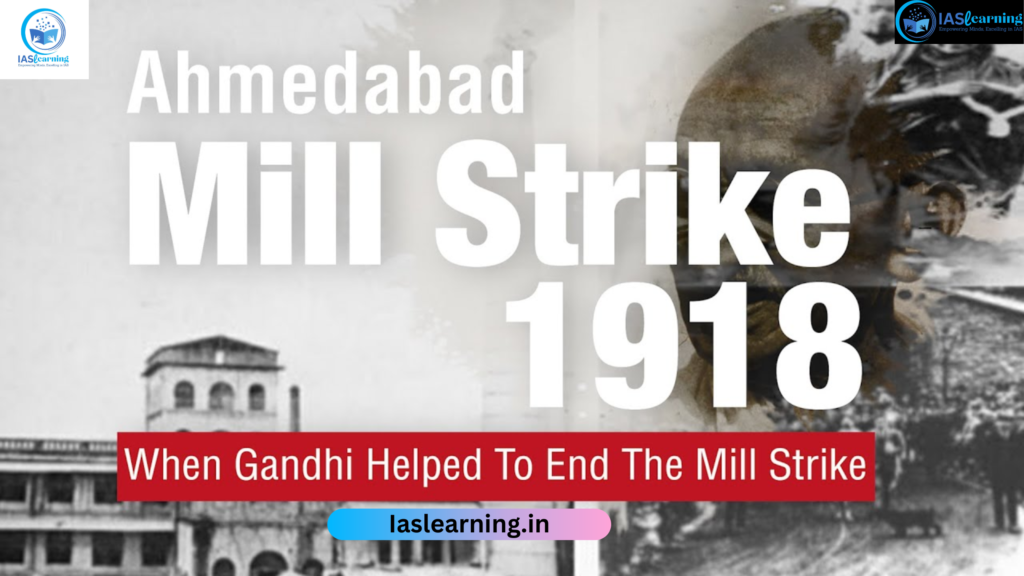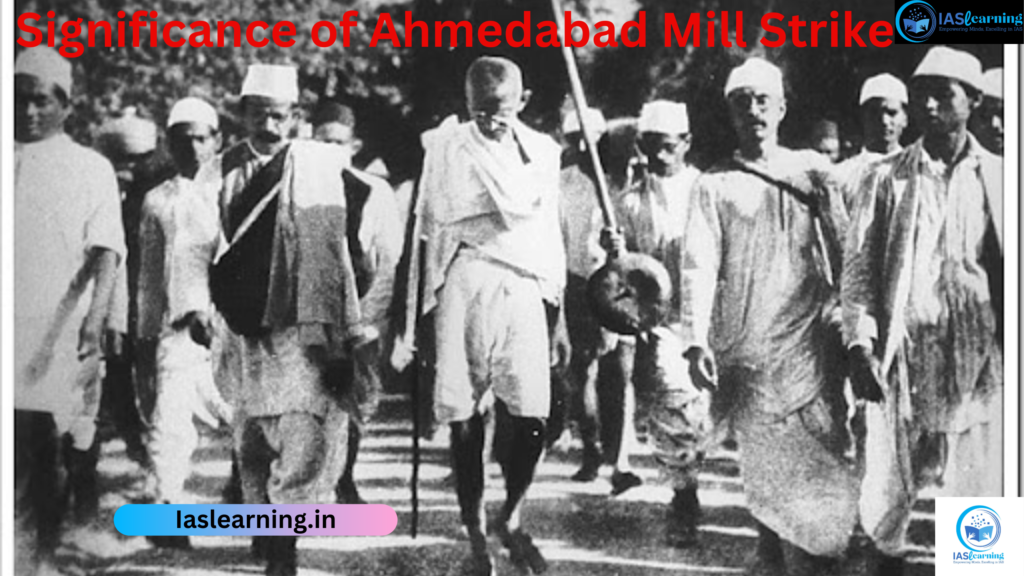Ahmedabad Mill Strike: During the independence fight, the Ahmedabad Textile Mill Labour Satyagraha of 1918 played a pivotal role in forming the working class movement. It took place in Ahmedabad in February and March of 1918, mostly led by textile mill workers who were launching a strike over poor working conditions. Mahatma Gandhi’s entry into the Movement and his support of worker-side negotiations gave it a boost.
The 1918 Ahmedabad Textile Mill Labour Satyagraha was one of Gandhi’s three initial attempts at a nonviolent satyagraha in India. As a way to guarantee the result, the Satyagraha popularized the “hunger strike” among the Indian populace.
Background of Ahmedabad Mill Strike – Working Conditions
Poor working conditions and labor exploitation were prevalent in British Indian industrial institutions throughout the early 1900s, particularly textile mills. Gujarat’s Ahmedabad had become a key hub for the manufacture of textiles because to its closeness to the port, rail, and British Enterprise. Indian entrepreneurs such as Ambalal Sarabhai and British mill owners owned its textile factories. However, the working conditions for mill workers were extremely difficult.
- Withdrawal of plague bonus:
- In 1917, an outbreak of plague in Ahmedabad prompted mill owners to offer a ‘Plague Bonus,’ which could amount to up to 75% of ordinary salaries, in an effort to keep workers from fleeing the area.
- Owners attempted to take the bonus away when the pandemic passed, but employees insisted on keeping it because of the high cost of living.
- Long hours of work and low wages:
- The majority of the poor farmers and migrants from rural regions who worked in Ahmedabad’s textile mills received poor wages. For working more than 70 hours a week, their average pay was about Rs 5.
- Workdays were long and difficult, lasting 12 to 15 hours. Women and children were also compelled to labor as part of the demanding task. Urban living expenses were also on the rise.
- War profiteering by mill owners:
- Prior to Indian independence, mill owners sought to make large profits from the wartime textile boom, as the Swadeshi idea gained momentum. They attempted to maximize outputs by abusing labor.
- Refusals were made regarding leave, minimum salary, accident benefits, and other amenities. Abuses and fines were frequent. Even while corporate profits skyrocketed, workers experiencing transitory output dips suffered disproportionately from layoffs or salary reductions.
For more : India Employment Report 2024
What happened during the Ahmedabad Mill Strike
The sequence of events and conditions that prompted the Ahmedabad Textile Labour Satyagraha of 1918 eventually resulted in the strike. These can be summarized as follows:
- Strike call and the condition of workers:
- In 1918, Ahmedabad’s textile mill workers were furious over their appalling working conditions in the face of rising earnings for the mill owners. Anasuya Sarabhai and other local leaders of newly formed unions spoke on behalf of the workers.
- However, the government disregarded calls for wage increases and set work hours. The demand for a nonviolent strike was made at a large-scale mill workers’ demonstration at the beginning of 1918. They decided to stop working unless the owners guaranteed equitable working conditions.
- Arrival of Gandhi and the Strike Demand:
- Mohandas Karamchand Gandhi received an invitation to Ahmedabad in February 1918 to lead the developing labor movement. On February 22, Gandhi called a conference where the requests were agreed upon.
- A 35% salary raise, an 8-hour workday, weekly holidays, overtime compensation, the elimination of penalties, better housing conditions, the reinstatement of fired employees, and other demands were among them. The mill owners received the demands.
For more : American Revolution 1776, History, Causes, Timeline and its Impacts
History of the World Before 18th Century
Gandhi’s Contribution to the Ahmedabad Mill Strike
Gandhi received a call immediately after the Champaran Movement was over by the Ahmedabad textile factory workers with a pressing request.

- Mass upsurge and unity:
- Gandhi called for a nonviolent nationwide strike on February 22, midnight, when the mill owners had not responded favorably to the requests.
- As planned, more than 100,000 families and textile workers peacefully picketed outside the mills early the following morning. Under Gandhi’s guidance, the massive strike continued in its disciplined non-violence for more than a week.
- The workers felt motivated by Gandhi’s presence, which also provided amazing camaraderie despite differences in language, religion, and caste. Unprecedented togetherness between Muslims and Hindus during the strike helped to heal mistrust between the communities.
- Ek tek slogans, peace marches, and pamphlets—all of which are effective communication tools—also contributed to the mobilization of orderly, nonviolent mass action. The workers’ nonviolent resilience allowed the initiative to stay with them throughout the satyagraha.
- British authorities’ partial concession:
- The mill owners were first fiercely opposed to negotiations, but with Gandhi’s help, they eventually gave in. About 35% of the initial demand was satisfied by the compromise deal, which also included a 20% pay increase.
- Gandhi viewed the truce as a tactical success of nonviolent pressure, despite the fact that many others thought it was insufficient. The acknowledgment of labor welfare and decent working conditions was a need for the authorities.
- The consequences of the Strike:
- As agreed upon, employees went back to work as more negotiations took place. On the other hand, the mill owners used retaliatory measures including firing striking leaders and reducing pay. Protests reappeared as a result of harassment.
- Fearing chaos, the owners ultimately consented to reinstate fired employees and bring back previous pay scales. Though problems continued, everything gradually returned to normal.
For more : What is the concept of Nation and State?
What is Constitutionalism And Consitutional Morality
Significance of Ahmedabad Mill Strike

Despite being a small-scale effort, the Ahmedabad Mill Strike of 1918 is incredibly important to the history of India’s independence movement. Its significance may be summarized simply as the following:
- Encouragement for the Indian labor movement:
- Strong trade unions like the Ahmedabad Textile Labour Association, which upheld Gandhian principles of nonviolence, independence, and peace between employers and employees, grew as a result of its success.
- Working class participation in the national movement:
- The national movement during the Gandhian period was characterized by widespread participation from nearly every segment of the Indian people.
- The Ahmedabad strike brought the working class into the national movement, just as the Champaran Satyagraha signified the incorporation of the peasant class.
- Fasting as an instrument for satyagraha and mass integration:
- Gandhi’s use of fasting proved to be a powerful and even coercive tool with potential usage in the future of the Indian national cause, since it forced a negotiated solution without violence.
- Fasting had a noticeable impact anytime there were class or communal divides during the national movement against the British and the Indian masses.
- Encouraging the use of arbitration to settle disputes:
- Workers’ selfless sacrifice demonstrated the fairness of the demands. The strike demonstrated the usefulness of arbitration in settling conflicts peacefully.
- Development of skills:
- At Gandhi’s ashram, laborers acquired skills in construction, weaving, and other related fields throughout the strike.
The 1918 Ahmedabad Mill Strike served as a useful example of how to implement Gandhian principles of nonviolence, mass mobilization, employee-employer interactions, and a positive program-based approach to better working conditions. It energized India’s liberation struggle by strengthening working-class unity against exploitation and creating significant connections between labor and national forces.
